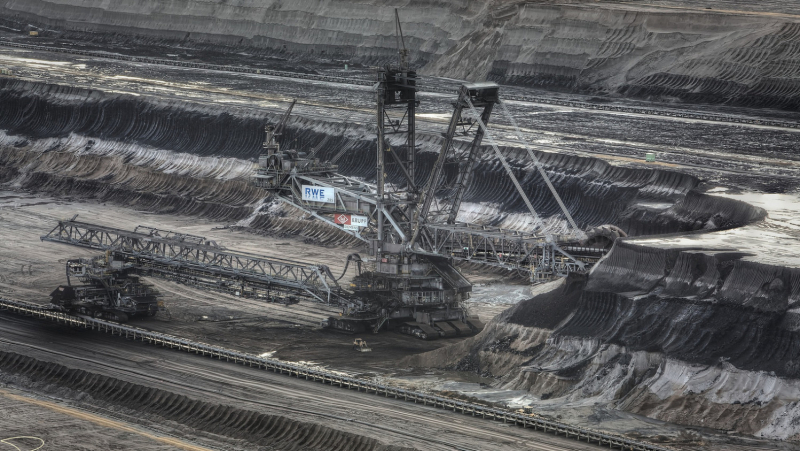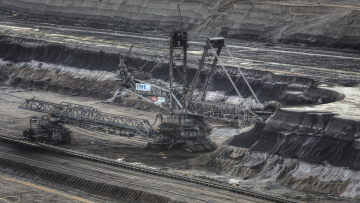Project – On record
This profile is no longer actively maintained, with the information now possibly out of dateBankTrack

Project – On record
This profile is no longer actively maintained, with the information now possibly out of dateBankTrack
Why this profile?
The Hambach open-cast lignite mine lies adjacent to the last remaining part of the 12,000 year old Hambach Forest. 90% of this once large forest has already been destroyed due to the expansion of the pit, and RWE (owner of the mine) is now planning to cut down half of the last remaining part as well.
In January 2019, following recommendations from the German Coal Commission, Germany has decided to end to coal-fired power generation in the country by 2038 at the very latest and has agreed on a shutdown schedule for individual lignite power plants. These plans have been translated into a draft coal exit law, which is currently being debated in the German parliament. RWE has agreed to leave the Hambach Forest untouched until the autumn of 2020.
What must happen
RWE operates several of the oldest, most CO2-intensive coal power stations, which will have to be phased out early for Germany to be on track for a Paris-compliant coal phase-out.
| Sectors | Coal Mining |
| Location |
|
| Status |
Planning
Design
Agreement
Construction
Operation
Closure
Decommission
|
| Website | http://www.rwe.com/web/cms/en/1858872/rwe-generation-se/fuels/location-overview/germany/hambach/ |
The Hambach open-cast mine (Hambacher Tagebau), owned by RWE, is located in North Rhine-Westphalia, Germany. The mine is the largest open-cast mine of Western Europe: it covers a surface of 8 by 10 kilometres and is around 500 metres deep. The mine has a coal output of 40 million tonnes per year and its operations make use of the largest automated machinery in the world (220 metres long, 96 metres high, 13,500 tonnes heavy).
Together with the coal outputs from Garzweiler and Inden - two other open-cast lignite mines in the area that are also owned by RWE - the Hambach mine's output is enough to produce 40% of the current power consumption of North Rhine-Westphalia. RWE has extraction rights for the mine until 2040.
Social and human rights impacts
Since the beginning of RWE's mining activities in the area, entire villages have been destroyed and more than 1,000 people have lost their homes. Moreover, the health of human beings has been negatively affected due to RWE's coal business. Coal-fired energy generation causes air pollution, which can affect people's health. Health issues that arise are illnesses (like bronchitis and asthma), but they can also result in premature deaths. Apart from the CO2 emissions causing health problems, the Hambach mine emits radioactive materials. These materials, when dissolved in rain, precipitate across Germany.
Environmental and climate impacts
The lignite that is mined from the Hambach mine is transported to several coal power plants of RWE. There, they are burnt, releasing toxics into the air. A third of the CO2 emissions in Germany are emitted in the Hambach-area. In addition to the CO2 emissions, the power stations in the area are responsible for the emission of 50 kilograms mercury and radioactive material into the atmosphere. These emissions produce fine respirable dust (more than is created by all traffic in Germany) and negatively affect both climate change and human health.
Apart from CO2 emissions and radioactive dust, the Hambach mine makes use of an enormous amount of water. Groundwater is pumped into the Rhine river in order to prevent the groundwater from flooding the mines. The water that is used equals five times the annual water consumption of the city of Cologne.
Furthermore, it is important to notice that the Hambacher Forest is one of Central Europe's last remaining ''primeval'' forests. The Forest has a long history which goes back to the end of the last Ice Age. The Forest is home to a diversity of flora and fauna, as well as a range of (endangered) species.
The Hambach mine is operated by RWE as part of its normal business operations and as such has no specific financiers. A list of financiers of RWE can be found here.
Germany: Police begin eviction of Hambach forest activists
2019
2019-03-13 00:00:00 | Court rejects lawsuit aiming to protect Hambach Forest
A court in the Cologne has rejected the lawsuit brought forward by BUND (the German Friends of the Earth) aimed at protecting the Hambach Forest. This leaves the future of the Hambach forest uncertain.
2019-02-20 00:00:00 | RWE agrees to leave Hambach Forest untouched until autumn 2020
RWE has agreed to refrain from clearing the Hambach Forest in the western state of North Rhine-Westphalia (NRW) until autumn 2020. The company has signed a one-year mortarium on logging. The German state said that the preservation of Hambach in the long-term would depend on the negotiations between RWE and the government over how to handle the national coal withdrawal plan.
2019-01-29 00:00:00 | Germany will exit coal by 2038
Germany plans to end coal-fired power generation by 2038 at the latest and has agreed on a shutdown schedule for individual lignite power plants as well as compensation payments for operators. For hard coal, the coal exit law foresees auctions for plant operators to take capacity off the grid according to the government's timetable. The government plans to implement the full coal exit law by the summer of 2020.
2018
2018-10-05 00:00:00 | German court orders suspension of Hambach Forest clearance
The senior administrative court of Münster told RWE that it must refrain from clearing the 12,000-year-old Hambach Forest, while awaiting its verdict on a lawsuit brought by environmental group BUND, the German branch of Friends of the Earth. BUND argued in its lawsuit that the ancient woodland should not be cleared because it is home to rare bat species.
2018-09-14 00:00:00 | DekaBank asks RWE to suspend clearing work
Via Twitter, DekaBank has asked RWE to suspend its clearing activities until the final recommendations of the Coal Commission are published. They stated that, as shareholders, they do not benefit from an escalation. Furthermore, they see the risk that RWE unnecessarily jeopardizes its reputation and future viability.

